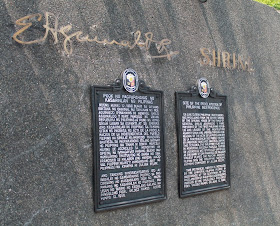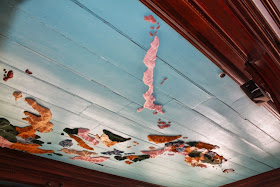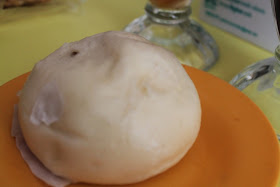As the saying goes “Its
better late, than never” – It took me a decade, concreting of
coastal into expressway, and the booming of Cavite population before
I had the chance to literally spend a day in Kawit Cavite. Shocking
in a sense that I’m a legitimate resident of Bacoor – a
neighboring municipality of Kawit that is 9.00 php bus ride away.
Feeling Patriotic, I decided to visit Kawit’s famous landmark – the historic Aguinaldo Shrine, site of the Proclamation of Philippine Independence. According to historical marker installed (at the entrance gate of shrine) – On June 12, 1898, Philippine Independence was proclaimed from the center window (now converted into balcony) of the original house of the family of General Emilio Aguinaldo, President of the first Philippine Republic and leader of the revolution against Spain and America. Through the reading of The Acta De La Proclamacion De La Independencia Del Pueblo Filipino by Ambrosio Rianzares Bautista, during this occasion, the Philippine flag made in Hong Kong by Dona Marcela Marino De Agoncillo was officially unfurled as the band of San Francisco De Malabon proudly played the March Nacional Filipina (now the Philippine National Anthem) Composed by Julian Felipe.
The shrine is open
Tuesday to Sunday from 8 am – 4pm; I was advised that March –
June is the perfect months to visit shrines with no visitors from
school field trips. Entrance is free of charge but be generous enough
to make donations (donation box located at souvenir shop). Visitors
are required to register, and soon a guide will promptly assist you
all the way. But first, some rules and regulations: (1)
Picture-taking for personal use is welcome, for commercial purposes,
please inform shrine personnel; (2) No pets allowed; (3) Food and
drinks are strictly prohibited; (3) No Smoking Policy; (4) Restricted
areas and glass casings are off limits.
According to our guide, Aguinaldo shrine is the biggest amongst other shrines, and that General Aguinaldo re-modeled his house from 1919 – 1920. The story of the Revolution is “written” in its architectural details and interior design. Before his death, he donated the estate to the Philippine government to perpetuate the spirit of the 1896 Revolution. As part of his last will, he wanted his remains be buried on his lot.
Some of the re-modeled
architectural and interior designs: (1) The spacious reception hall
has a three section ceiling, featured are the dove, the sun motif and
mother Philippines – icons referring to the Filipino desire for an
independent nation. (2) Formal Dining Room – on the ceiling is a
relief map of the Philippines; Cavite was painted red because it was
considered the center of the Revolution; above the window are
paintings on glass portraying his wives and children. (3) The center
window where Philippine Independence was
proclaimed was converted into balcony.
Shrine has its preserved heavy wood; capiz windows; balusters and concrete that had served witness history in making. Ground floor enshrined collected memorabilia from plate number dated 1896; Rayadillo Uniform – blue and white rayadillo uniform used as official uniform of revolutionaries; canons that had mightily fought for our freedom; books that had tactically utilized by revolutionaries to outsmart their opponents; the bowling alley which is first in the Philippines; and images that documented story of history worth remembering.
The second floor is like
General Aguinaldo welcomes us and opens books on personal note. The
spacious and grandiose scene had made me conclude that Aguinaldo’s
as wealthy family – Grand piano as center piece; Reception room –
where journalist, politicians and important guests requiring a
private audience with the General were led to this room (sometimes it
was called the Music Room because the family radio was here; Formal
Dining Room – Aguinaldo’s special guests dined on the massive
table during important occasions and parties; Kitchen – also found
the servant’s quarter on the mezzanine; with ice boxes built into
the wall; The Balcony of Sinners – The General playfully named the
balcony as such because it was where the Revolutionaries plotted
military strategies; the balcony also served as the family’s lounge
on lazy afternoons, and according to family stories, courtships
leading to marriages began in balcony of sinners; Bedroom of the
Aguinaldo Daughters – The rooms of Cristina Suntay, Maria Poblete
and Carmen Melencio was in fashion in the early 20th
century with furnishings and accessories with mixture of European,
Chinese and Filipino styles; A mezzanine library is where musicians
played for the General’s grand parties, that overlooks the living
room; Ambassador’s Room – Ambassador Jose P. Melencio, Carmen
Aguinaldo’s husband, used it as study; Swimming pool – though it
was not covered with tiles but white painted plain concrete, still
they have swimming pool!; The uppermost bedroom belonged to the
General (which happened to be restricted area).
The Shrine also raised intrigued and curiosity with those secret doors that led from one room to another such as the Dining Table - to make a quick escape, one must raised the dining room’s heavy table top revealing a passageway to the underground shelter; One wall panel of the music room is a hidden door leading to the upper floor of the house.
Exiting is view of marble stone with engraving “Emilio Aguinaldo 1869 – 1964” with eight (8) Philippine flags proudly waving; this tells me that my tour had ended but my freedom and independence as a Filipino lives forever and I owe it to hero – General Emilio Aguinaldo and the Revolutionaries.


















































